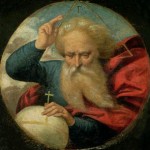I have a body, you have a body, and…..
we’ve gotten used to God (the Father) having one too. “The Man Upstairs” We’ve heard this dysphemism, right?
This almighty person* of the three-in-one Godhead, who is the center of Reality, is the One Jesus invited us to respectfully, personally, and literally, address as “Dad” in our prayers.
Yep, this is probably why the male depictions crop up. And, it’s not surprising that since God has been around for quite a while (okay. That is hyperbole….it’s been forever and ever) that he would be depicted as elderly. There’s the white hair, wrinkles, and, of course mad skillz at wisdom etched in the contours of his face. He’s usually shown as robed (relaxed fit clothing , perhaps), light-skinned (really huge shock, right? Thanks, Rome.), and bearded. There’s a verse about Jesus having the hair in his beard ripped out, but God the Father having a beard, well, maybe he’s just too busy to shave? Did famous Greek Stoics look like this, so it was a jumping off point for artists? God, so many questions…
AND-Yes, curiously the depictions appear very much like Father Christmas (Santa Claus). If you think about that bit for too long, it will start to get creepy; especially with those holiday songs that include lines, “he sees you when your sleeping…” and such.
Here’s the part where I pop the fantasy bubble, like it or not.
God is not a man.
God does not have a body.
“He” isn’t “upstairs”.
That deity in art, and in our minds, looks like a human, and acts as such. It’s human created. The street term sadly, I’m sorry to say, this is, an idol. There, I said it.
More importantly to our spiritual growth, those types of pictures of God are bitty and short-changed. God does not have body parts, or biology to make God one or another gender. Jesus, and others may say “he” for God because it is a term of relationship. It is a gift of grace, goodness, and love toward us (as children) that no human father can accomplish perfectly well. But God can. God displays qualities most often distinctive to both genders respectively, and in perfection and holiness.
God is everywhere. Let’s just try to wrap our brains around this a bit, because we are not at all everywhere. I’ll just repeat it: God is everywhere. This is one big benefit a Spirit Being has, someone like “the man upstairs” is only, well, upstairs. And sometimes downstairs, but not both at the same time. This is where Deism is straight out against the Trinitarian percepts of the Bible. Deism, separates God from his creation: God-The Watchmaker. Distant, Aloof. It’s just dead wrong, because Jesus called him Father, and invited us to do so, too.
To perform an act of God in the flesh (in human form) Perfect God needed a body. So, yes, God incarnated a real human body to heal and redeem humans, body and spirit.
That incarnation: Jesus, the Anointed One.
The Holy Spirit, also a full member of the three-in-one Godhead (not just a pale bird in flight above a placid, pasty, bearded white guy often seen in artistic depictions), is the full power of God that is with us who receive God and Jesus. This Being, works on us to teach us, and transform us into Jesus’ character, what we call “Christ-likeness”.
In a recent survey, Two out of Three members of the Trinity prefer being body-free.
From Jesus, written by John in Chapter 4. Verse 23 “Yet a time is coming and has now come when the true worshipers will worship the Father in spirit and truth, for they are the kind of worshipers the Father seeks. 24God is spirit, and his worshipers must worship in spirit and in truth.”
*(person here does not signify a human person (i.e. human individual), but instead, one with a personality. personality |ˌpərsəˈnalitē|noun ( pl. -ties)1 the combination of characteristics or qualities that form an individual’s distinctive character). In mystic tradition there is some issue there too.
Now it’s your turn.
Like me, have you ever thought of God the Father as a man? Or an old man in the sky?
Or a Being with a body?
How do you image or imagine God?
Which artistic depiction of God (shown above) do you find the strangest, or most fascinating?
All Comments welcome.
thank you.




